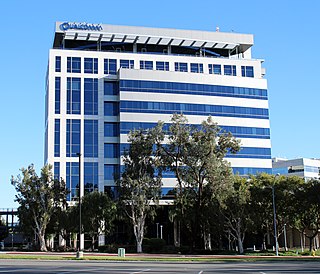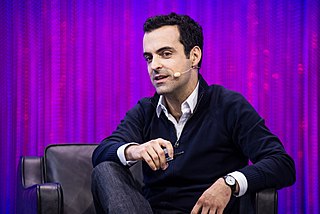
Qualcomm Incorporated is an American multinational corporation headquartered in San Diego, California, and incorporated in Delaware. It creates semiconductors, software, and services related to wireless technology. It owns patents critical to the 5G, 4G, CDMA2000, TD-SCDMA and WCDMA mobile communications standards.

Brazilian Silicon Valley is a term commonly applied to the region of Campinas and in southern region this term is applied for Florianópolis city, Brazil because of its similarity to the 'original' Silicon Valley, located in California in the USA.

A satellite telephone, satellite phone or satphone is a type of mobile phone that connects to other phones or the telephone network by radio link through satellites orbiting the Earth instead of terrestrial cell sites, as cellphones do. Therefore, they can work in most geographic locations on the Earth's surface, as long as open sky and the line-of-sight between the phone and the satellite are provided. Depending on the architecture of a particular system, coverage may include the entire Earth or only specific regions. Satellite phones provide similar functionality to terrestrial mobile telephones; voice calling, text messaging, and low-bandwidth Internet access are supported through most systems. The advantage of a satellite phone is that it can be used in such regions where local terrestrial communication infrastructures, such as landline and cellular networks, are not available.

The history of mobile phones covers mobile communication devices that connect wirelessly to the public switched telephone network.
Adreno is a series of graphics processing unit (GPU) semiconductor intellectual property cores developed by Qualcomm and used in many of their SoCs.

MediaTek Inc. is a Taiwanese fabless semiconductor company that provides chips for wireless communications, high-definition television, handheld mobile devices like smartphones and tablet computers, navigation systems, consumer multimedia products and digital subscriber line services as well as optical disc drives.
Universal Flash Storage (UFS) is a flash storage specification for digital cameras, mobile phones and consumer electronic devices. It was designed to bring higher data transfer speed and increased reliability to flash memory storage, while reducing market confusion and removing the need for different adapters for different types of cards. The standard encompasses both packages permanently attached (embedded) within a device (eUFS), and removable UFS memory cards.

Snapdragon is a suite of system on a chip (SoC) semiconductor products for mobile devices designed and marketed by Qualcomm Technologies Inc. The Snapdragon's central processing unit (CPU) uses the ARM architecture. As such, Qualcomm often refers to the Snapdragon as a "mobile platform". Snapdragon semiconductors are embedded in devices of various systems, including vehicles, Android, Windows Phone and netbooks. In addition to the processors, the Snapdragon line includes modems, Wi-Fi chips and mobile charging products.
Sanjay Kumar Jhā is an Indian-American business executive. He is the former chief executive officer (CEO) of GlobalFoundries and former chairman and CEO of Motorola Mobility. Prior to that, he was the chief operating officer of Qualcomm.
Hélio Waldman is a Brazilian scientist best known for his work as rector of the Universidade Federal do ABC, UFABC (2010–2014) and as dean of research at the Universidade Estadual de Campinas, Unicamp (1986–1990). Currently working as a researcher and rector of UFABC.

Xiaomi Corporation, commonly known as Xiaomi and registered as Xiaomi Inc., is a Chinese designer and manufacturer of consumer electronics and related software, home appliances, automobiles and household hardware. It is the second-largest manufacturer of smartphones in the world, behind Samsung, most of which run on the MIUI operating system, which is based on the Android operating system. The company is ranked 338th and is the youngest company on the Fortune Global 500.
Hexagon is the brand name for a family of digital signal processor (DSP) products by Qualcomm. Hexagon is also known as QDSP6, standing for “sixth generation digital signal processor.” According to Qualcomm, the Hexagon architecture is designed to deliver performance with low power over a variety of applications.

Hugo Barra is a Brazilian computer scientist, technology executive and entrepreneur. From 2008 to 2013, he worked in a number of product management roles at Google, including vice president and product spokesperson of its Android division. From 2013 to 2017, he worked at Xiaomi as vice president of global operations. From 2017 to 2021, he worked as vice president of Virtual Reality and head of the Oculus division at Meta Platforms. In May 2021, he left Meta to join health technology startup Detect as CEO.

Quick Charge (QC) is a proprietary battery charging protocol developed by Qualcomm, used for managing power delivered over USB, mainly by communicating to the power supply and negotiating a voltage.

Jacobus Swart is a professor at State University of Campinas - UNICAMP, Campinas, Brazil and was named Fellow of the Institute of Electrical and Electronics Engineers (IEEE) in 2014 for contributions to microelectronics education in Brazil.
The HTC U series is a line of upper mid-range and high-end flagship Android smartphones developed and produced by HTC. The first phones in the series, the HTC U Play and the HTC U Ultra, were announced in January 2017. The HTC U series is the successor of the HTC One series.
VinSmart Research & Manufacturer Joint Stock Company is a member of Vingroup Joint Stock Company – one of the biggest wholly owned conglomerates in Vietnam, specialising in Technology, Industry, Commercials & Services. VinSmart was established in June 2018.

The Samsung Galaxy A52 is a mid-range Android-based smartphone developed and manufactured by Samsung Electronics as a part of its Galaxy A series. The phone was announced on 17 March 2021 at Samsung's virtual Awesome Unpacked event alongside the Galaxy A72.











